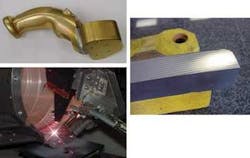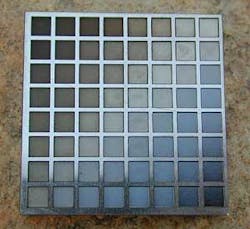South Africa steps up laser material processing
With a capital investment plan in place, the National Laser Center works to transfer technology to industry and further research and development
W. Klopper
In a previous Global Report (ILS December 2000), events leading to the formation of the National Laser Centre (NLC) in 2000 were reviewed. Through the combination of laser expertise and equipment then residing at the Nuclear Energy Corporation of South Africa (NECSA) and the Council for Scientific and Industrial Research (CSIR) as well as funding from the South African Department of Science and Technology (DST) the NLC was established as an independent trust to ascertain the viability of its operating model. The NLC’s subsequent success in delivering innovative technical solutions to industry, support to higher education institutions, and evident financial sustainability prompted the DST to incorporate the NLC into the CSIR in 2003.
null
Facilities
Because laser material processing relies on state-of-the-art facilities a capital investment plan for high-power laser equipment was formulated. The first acquisition was a 5kW TRUMPF TLC 1005 high beam quality CO2 laser machining center with a processing cell incorporating five-axis gantry style beam delivery. The system became operational in 2001 and provides 3D profile cutting (see Figure 1) and deep penetration welding services nowhere else available in the country. The CO2 system was also extensively used for process development and research in transformation hardening, cladding and welding.
A 4.4kW diode-pumped Rofin-Sinar DY 044 was purchased and commissioned early this year. Its flex-ible fiberoptic beam delivery, multiplexing capability (one laser source serving many workstations), and higher absorption of its wavelength on metals are the principle advantages. Laser processing heads are mounted on a high-precision Kuka robot. The fact that there is already a number of Nd:YAG installations in local automotive plants contributed toward the decision to invest in this technology. NLC is now positioned to offer local support to industrial users through process development, trouble shooting, and training.
Interest in micromachining from local industry was gauged but no well-defined need for laser processing services or development below ~100 µm feature size was found. This information, combined with experience gained from participation in a local Innovation Fund project relating to the tooling industry pointed to opportunities offered by a laser ablation system in the dimensional range known as Meso Processing. A Deckel Maho laser ablator was purchased in 2004 and is seeing intensive use creating small dies and molds (see Figure 2). It also serves for developing complex tool textures and research into laser polishing.
In-house developments include the completion of a low-power facility utilizing a 200W slab CO2 laser for cutting polymer materials in a thickness range not commonly available from local service providers.
A fine cutting facility based on pulsed Nd:YAG sources has also been set up for applications such as the cutting of small tubes and sectioning of layers used in solar panel production.
Market forces
Market surveys indicated the prevalence of laser marking and flatbed cutting introduced by foreign suppliers responding to well-defined opportunities in the South African market. The market for flatbed cutting machines remains active despite a decade of strong growth. A number of steel tube mills and automotive assembly lines has dedicated laser welding installations as prescribed by international parent companies.
Technology implementation
The South African automotive, steel, power, and petrochemical industries are receptive to more advanced manufacturing techniques such as laser profile cutting, welding, cladding, hardening, and deep engraving (see Figure 3). The NLC is instrumental in selectively transferring these technologies to local industry through a strong international network of partnerships.
This is accomplished by combining each system acquisition with extensive training at the facilities of the supplier as well as leading European laser institutes. During local commissioning of facilities training opportunities for technical personnel are maximized. The local knowledge base in each application is then fleshed out by engaging in a limited number of feasibility trials for lead clients. As processes start becoming routine, they are offered as specialized manufacturing services.
The NLC’s capabilities have been extended by acquiring accessories for both the CO2 and Nd:YAG systems, which allow hybrid welding and real-time process monitoring. Powder cladding can be performed with off-axis, co-axial (precision) and three-way (positional) nozzle configurations.
Research and development
With the CSIR celebrating its 60th birthday this year, an organizational review and redesign process was launched. A key theme is the re-establishment of the organization’s research capacity in line with national policy, which aims to increase R&D spending.
Through contact with local industry and academia, research topics were identified that meet the dual criteria of local relevance and the opportunity for research at a level that aids in the development of world-class researchers. At present, studies in the area of surface modification include laser polishing, corrosion prevention, and adhesion enhancement (see Figure 4). The latter is being pursued through a researcher exchange program between France and South Africa with a focus on the surface preparation of aluminum before plasma spraying of a metallic coating.
The laser cleaning studies initiated in 2000 have been steered towards application in nuclear decontamination. The strong ties to NESC in South Africa and the French nuclear concern COGEMA pointed the way to potential application of the NLC’s laser coating removal expertise in the selective removal of radioactively contaminated surface layers. For the purpose of pursuing this work, a NLC laboratory is maintained on the terrain of the Nuclear Energy Corporation. A mobile laser paint removal system was recently demonstrated while research is continuing on determining laser removal parameters for radioactive contaminants in metal substrates.
In the fields of welding and cladding, industry requests revealed a need for research involving metallurgical expertise, so a number of novel applications are being pursued. The welding of maraging steel was successfully accomplished after comparing the results obtainable with single spot, twin spot, and scanner welding. The current research emphasis is on the laser welding and cladding of aluminum for well-known applications in transport. A research project in collaboration with the CSIR: Light Metals Development Centre aims to provide superior weld quality in semi-solid metal die cast aluminium parts and to develop hard-facing solutions to reduce wear on aluminium surfaces.
A combination of laser cladding and surface re-melting processes are being investigated for solving problems with stress corrosion cracking along welds in tubes carrying pressurized water. Laser cladding is also being evaluated as a method of refurbishing continuous casting rollers used in local steel mills.
The NLC is keen to attract international research partners to collaborate in its research activities.
Wouter Klopper ([email protected]) is the business area manager for laser materials processing at CSIR: National Laser Centre, Pretoria, South Africa.





